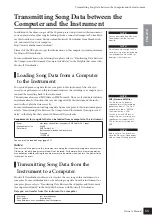
Detailed Settings – [FUNCTION]
Owner’s Manual
48
ENGLISH
You can make detailed adjustments to MIDI
settings.
For more information about MIDI, see the
“About MIDI” section (page 51).
1. Engage the Function mode and select
.
2. Press the [+/YES] button to engage the MIDI
function’s sub-mode, then use the [TEMPO/
FUNCTION
▼
,
▲
] buttons to select the
desired sub-mode.
Press the [–/NO] or [+/YES] button to set a
selected parameter.
Sub-mode
F6.1: MIDI Transmit Channel Selection
In any MIDI control setup, the MIDI channels of the
transmitting and receiving equipment must be matched
for proper data transfer.
This parameter enables you to specify the channel on
which the instrument transmits MIDI data.
Setting range:
1 – 16, OFF (not transmitted)
Normal setting:
1
F6.2: MIDI Receive Channel Selection
In any MIDI control setup, the MIDI channels of the
transmitting and receiving equipment must be matched
for proper data transfer. This parameter enables you to
specify the channel on which the instrument receives
MIDI data.
Setting range:
ALL, 1&2, 1 – 16
Normal setting:
ALL
F6.3: Local Control ON/OFF
“Local Control” refers to the fact that, normally, the key-
board controls its internal tone generator, allowing the
internal voices to be played directly from the keyboard.
This situation is “Local Control On,” since the internal
tone generator is controlled locally by its own keyboard.
Local control can be turned OFF, however, so that the
keyboard does not play the internal voices, but the
appropriate MIDI information is still transmitted via the
MIDI OUT terminal when notes are played on the key-
board. At the same time, the internal tone generator
responds to MIDI information received via the MIDI IN
terminal.
Setting range:
ON/OFF
Normal setting:
ON
F6.4: Program Change ON/OFF
Normally the instrument will respond to MIDI program
change numbers received from an external keyboard or
other MIDI device, causing the correspondingly-num-
bered voice to be selected on the corresponding channel
(the keyboard voice does not change). The instrument
will normally also send a MIDI program change number
whenever one of its voices is selected, causing the corre-
spondingly-numbered voice or program to be selected
on the external MIDI device if the device is set up to
receive and respond to MIDI program change numbers.
This function makes it possible to cancel program
change number reception and transmission so that
voices can be selected on the instrument without affect-
ing the external MIDI device.
Setting range:
ON/OFF
Normal setting:
ON
F6.
MIDI Functions
NOTE
In Dual mode, Voice 1 data is transmitted on its specified channel
and Voice 2 data is transmitted on the next greater channel number
relative to the specified channel. In this mode, no data is transmitted
if the transmit channel is set to “OFF.”
NOTE
Song data is not transmitted via the MIDI connections. However,
channels 3 – 16 of Disklavier Piano Soft songs, and non-protected
External songs will be transmitted via the MIDI connections depend-
ing on the Song Channel Selection setting (page 47).
NOTE
ALL:
“Multi-timbre” Receive mode. This allows simultaneous reception of
different parts on all 16 MIDI channels, enabling the instrument to
play multi-channel song data received from F6.6 or sequencer.
1&2:
“1&2” Receive mode. This allows simultaneous reception on chan-
nels 1 and 2 only, enabling the instrument to play 1 and 2 channel
song data received from a music computer or sequencer.
NOTE
Program change and other like channel messages received will not
affect the instrument’s panel settings or the notes you play on the
keyboard.
NOTE
No MIDI reception occurs when Demo mode is engaged or during
file operations.
NOTE
For information on program change numbers for each of the Instru-
ment’s voices, Refer to MIDI Data Format on the web site.
http://www.yamaha.co.jp/manual/









































